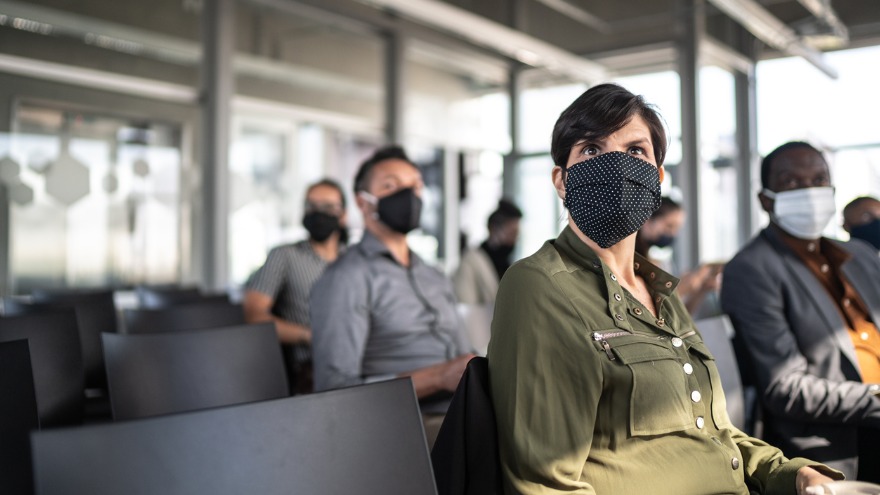When everyone returns to meeting venues again, meeting professionals will have a whole new list of concerns on their checklists. From virus contagion to computer bugs, planning for the worst will be essential for delivering the best experience. Smart Meetings asked RJ Frasca, vice president of marketing and product with background screening company EBI for a shortlist of proactive steps that could save heartache later.

1. What will meetings and events look like in 2021 and beyond?
There has been a lot of speculation that hybrid events are here to stay, allowing attendees to choose whether to attend in person or virtually. People will be expecting shows to provide that hybrid option and deliver an equally valuable experience on both fronts. From a marketing perspective, replacing the value of face-to-face meetings may seem daunting; but technology companies have heard these concerns and are constantly striving to deliver solutions that work.
Our research indicates convention planners are beginning to plan out what types of health and safety tools they’d like to incorporate into hybrid and in-person events. We’ve spoken to at least one conference provider who will be having an on-site Chief Safety Officer who will manage the protocols being put in place.
2. The risk of transmitting illness stopped events from occurring. What are key lessons venues and planners should take away from the past year?
Venues and planners experienced enormous revenue loss in 2020. The convention industry was worth $1 billion annually before the pandemic. Moving forward, I would say venues should very carefully map out how they will handle health and safety best practices to mitigate risk. Defining and executing a well-thought-out health and safety plan will protect the venue from liability and give confidence to attendees and sponsors that it is okay to attend the event in person.
More: How to Budget Realistically for Hybrid Meetings
When it comes to planners, I would say the biggest lesson from 2020 should be always to have a Plan B. Contingency planning is key, as uncontrollable events and decisions could significantly impact a show. By having options and alternatives available for both attendees and sponsors, you can minimize the impact on revenue.
3. How can technology help venues and conference centers amplify social distancing during a busy event?
Whereas social distancing is the most effective means of avoiding exposure, many supplemental technology-based solutions can help keep everyone safe. For instance, conference apps can include a daily questionnaire to determine symptoms or potential exposure to COVID-19 or another illness. The app could pass/fail attendees for entrance to exhibit halls or breakout sessions. Entry points could then capture temperature, further eliminating chances of a potential breakout occurring. Distance monitoring and contact tracing solutions can be implemented by simply including an ultra-wideband tracker tile in lanyards worn at the show.
4. What is the best approach to contact tracing should an outbreak occur during or after an event or conference?
Contact tracing can be a huge undertaking when done manually. Data shows more than 70 percent of critical contacts may be missed without a digital tracing solution as part of an interview-based contact tracing protocol, which is a staggering statistic.
Solutions are available that automate the contact tracing process and decrease the notification time for those potentially exposed from days to mere minutes, stemming the spread of illness that much faster. One of the most reliable contact tracing devices is an extremely lightweight distance-monitoring sensor (15 grams) that uses ultra-wideband technology to pinpoint attendees’ proximity to one another. The device sends an alert when people are too close to one another. The technology also allows for accurate and efficient contact tracing.
Three out of four users feel safer at work while wearing an ultra-wideband contact tracing device. The numbers speak for themselves.
5. How can we best utilize technology to ensure hybrid events are safe and successful?
Technology will be key in all areas to ensure both safety and success. For those attending in person, technology can minimize potential exposure, measure symptoms or notify those who may have been potentially exposed. Finding a system that consolidates all the health and safety data is key when it comes to management and deployment.
Start communicating early! Continue to educate and explain exactly how you will be keeping everyone safe. Communication is key in making everyone more confident about getting back to conferences and feeling safe doing so. Utilizing a customizable app can help you populate messages to registered attendees long before the conference begins so they are well-informed about health and safety guidelines. This includes what personal protection equipment will be required throughout the venue. People are now accustomed to wearing masks, social distancing and using hand sanitizer. By following the same practices they’ve been using for more than a year, there is no reason people can’t safely network and meet face-to-face at shows.
RJ Frasca is vice president of marketing and product of EBI, a leading background screening provider and EBI Workplace Health & Safety, its comprehensive monitoring, tracing and data insights platform. Frasca brings over 20 years of marketing and product experience with companies such as Yahoo, Microsoft, Time Warner and Verizon.




